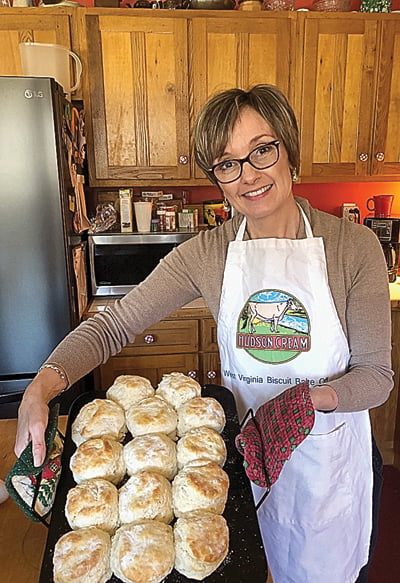
Cara Rose,
Executive Director
Pocahontas County Convention and Visitors Bureau
What is it about biscuits?
I think what makes the Appalachian biscuit better than Pillsbury’s is the art of making something delicious – fast, with simple ingredients. The biscuit was an easy way to put bread on the table every day. And it was inexpensive at a time when farming was the way of life in the mountains and hearty meals were demanded.
For many folks, still to this day, the biscuit is part of the everyday meal. The tried, true skill of taking a simple recipe and turning it into a mouthwatering, golden brown, light and fluffy biscuit makes the traditional Appalachian biscuit the star in the crown for most country bakers.
I don’t consider myself a very good cook but one thing I can do well is make a biscuit.
The art of making the perfect biscuit is not rocket science. In fact, it is basic technique. The tradition of the easy-to-whip-up biscuit is one that runs deep in the Appalachian Mountains.
I actually took a particular liking to making biscuits when I was young. In fact, it was one of the only things I enjoyed making in the kitchen. I learned the traditional technique from my mother, making the full-blown recipe of flour, baking soda, baking powder, sugar, shortening and cutting the biscuits perfectly for the perfect rise, perfectly browned. They never failed and were melt-in-your-mouth delicious every time. I had the charm for making them.
Then, years later, I was introduced to the simpler version by Reta Rose, who in my opinion is the epitome of the country cook. She showed me how to make the self-rising Hudson Cream Flour version that is down right to-die-for.
So, what does it take to make a remarkable biscuit?
Fresh flour is paramount. Not just any flour either. Hudson Cream Flour is the best. It is perfectly balanced and extremely soft and silky, which makes for a perfect light and fluffy biscuit.
Practice and patience is another key to becoming famous for your biscuits. The size must be hearty and tall. The bake must be light, fluffy and moist inside and of course flaky.
Simple measuring makes it easy with self-rising flour. Measure one liberal tablespoon scoop of shortening to each cup of flour. Sift your flour – it does make a difference!
I keep the sifter in the flour can so I have it ready to use.
Blend with a fork or pastry blender and pour in the milk. I use basic two percent milk and rough guess the quantity. I look for a stiff batter but if I get too much milk, I throw in a handful of flour. If I haven’t gotten enough milk, I pour in small amounts until I get the right consistency. This is the part that takes time and practice.
Don’t overwork the batter when mixing. After finding the right consistency, dump the mixture onto a piece of flour coated waxed paper and let the kneading do the rest of the work. Fold over the dough with loose flour approximately six times using your waxed paper until a somewhat smooth dough forms.
Don’t worry about the dough being perfect, unless you like it that way.
Press out the dough with your palms to a good thickness. Don’t even worry about using a cutter. I do use an oversized biscuit cutter, but you can use a glass like Reta does for the perfect size she likes. Find your size and stick with it!
Lay the biscuits against one another on any kind of pan or iron skillet, this gives them lift as they bake. Form the leftover bits of dough into that last biscuit and presto, you have your “cat head” biscuit!
Bake at 425 degrees for 15 minutes.
You will have the perfect biscuit and your family will be fighting over the cat head!
Served with sausage gravy, chipped beef gravy or a dab of butter and apple butter, you cannot go wrong!
For a variation, I sometimes add several scoops of sugar to the mixture and make a quick strawberry short bread served with strawberries and cream.
Now, back to the name “Cat Head.”
My father always calls the last misshapen and oversized biscuit “the cat head.”
My girls, when very young, always laughed at it and fought over the cat head when the pan of biscuits came out of the oven piping hot.
I did some research and it sounds like it definitely is a cultural saying from the spine of the Appalachian Mountain range and refers to a pan of oversized biscuits roughly the size of a cat’s head. This makes me want to make an entire pan of cat head biscuits!
I’ll stick to making one cat head biscuit with the leftover dough, and the next time you have a little dough left over, don’t throw it away.
Make a cat head biscuit and it will quickly become everyone’s favorite.
Who wants the cat head?



